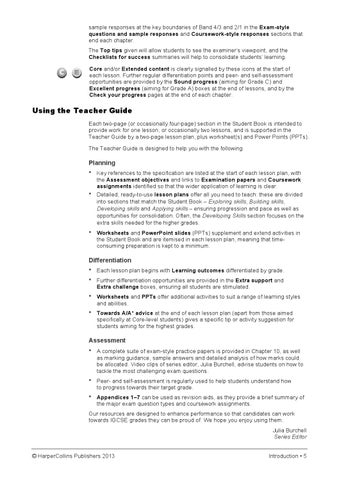sample responses at the key boundaries of Band 4/3 and 2/1 in the Exam-style questions and sample responses and Coursework-style responses sections that end each chapter. The Top tips given will allow students to see the examiner’s viewpoint, and the Checklists for success summaries will help to consolidate students’ learning.
C
E
Core and/or Extended content is clearly signalled by these icons at the start of each lesson. Further regular differentiation points and peer- and self-assessment opportunities are provided by the Sound progress (aiming for Grade C) and Excellent progress (aiming for Grade A) boxes at the end of lessons, and by the Check your progress pages at the end of each chapter.
Using the Teacher Guide Each two-page (or occasionally four-page) section in the Student Book is intended to provide work for one lesson, or occasionally two lessons, and is supported in the Teacher Guide by a two-page lesson plan, plus worksheet(s) and Power Points (PPTs). The Teacher Guide is designed to help you with the following.
Planning
• •
•
Key references to the specification are listed at the start of each lesson plan, with the Assessment objectives and links to Examination papers and Coursework assignments identified so that the wider application of learning is clear. Detailed, ready-to-use lesson plans offer all you need to teach: these are divided into sections that match the Student Book – Exploring skills, Building skills, Developing skills and Applying skills – ensuring progression and pace as well as opportunities for consolidation. Often, the Developing Skills section focuses on the extra skills needed for the higher grades. Worksheets and PowerPoint slides (PPTs) supplement and extend activities in the Student Book and are itemised in each lesson plan, meaning that timeconsuming preparation is kept to a minimum.
Differentiation
• •
Each lesson plan begins with Learning outcomes differentiated by grade.
•
Worksheets and PPTs offer additional activities to suit a range of learning styles and abilities.
•
Towards A/A* advice at the end of each lesson plan (apart from those aimed specifically at Core-level students) gives a specific tip or activity suggestion for students aiming for the highest grades.
Further differentiation opportunities are provided in the Extra support and Extra challenge boxes, ensuring all students are stimulated.
Assessment
•
A complete suite of exam-style practice papers is provided in Chapter 10, as well as marking guidance, sample answers and detailed analysis of how marks could be allocated. Video clips of series editor, Julia Burchell, advise students on how to tackle the most challenging exam questions.
•
Peer- and self-assessment is regularly used to help students understand how to progress towards their target grade.
•
Appendices 1–7 can be used as revision aids, as they provide a brief summary of the major exam question types and coursework assignments.
Our resources are designed to enhance performance so that candidates can work towards IGCSE grades they can be proud of. We hope you enjoy using them. Julia Burchell Series Editor © HarperCollins Publishers 2013
Introduction • 5
